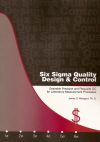Six Sigma
Six Sigma - Patient Data for Assessing Process Performance and Stability
Patient Data and Six Sigma together? Yes, the two most advanced QC techniques can work together. In fact, the two make a powerful combination. This application illustrates the use of both Sigma-metrics and Patient Data QC (also known as Average of Normals, AoN, Average of Patients). Patient Data QC uses patient test results to assess the performance of a laboratory testing process and to identify changes in process stability. This application strategy fits together with the strategy of multistage quality control, which employs multiple QC designs to accomplish specific objectives. (Preview)
- What's the Patient Data/Average of Normals(AoN)?
- Potential usefulness of AoN applications
- Performance vs Process Sigma Metric
- Performance vs spop/smeas ratio
- Necessary or available number of patient samples
- Applicability in a Specific Laboratory
- Design of AoN algorithms
- What's the point?
- References
This application illustrates an advanced combination of Quality Control techniques: using both Sigma-metrics and Patient Data QC (also known as Average of Normals, AoN, Average of Patients). Patient Data QC uses patient test results to assess the performance of a laboratory testing process and to identify changes in process stability. This application strategy fits together with the strategy of multistage quality control, which employs multiple QC designs to accomplish specific objectives. In the ideal world, a QC procedure should provide high detection of medically important errors, low false rejection, and low cost, i.e, require only a few measurements. When ideal performance cannot be achieved with a single QC procedure, then multiple QC designs can be employed to accomplish specific purposes. The generic structure for a multi-stage laboratory QC system would have three stages:
- Startup QC for high error detection;
- Monitor QC for low false rejection;
- Patient data QC for measurement of run length.
This strategy generally becomes applicable when the process capability is less than 5-sigma and usually is necessary when less than 4-sigma. Even processes having less than 3-sigma performance may be adequately monitored if the patient data QC can be properly designed.
What's the Patient Data/Average of Normals?
The utilization of patient data for process control is of much interest in the new millennium. The 2000 annual meeting of the American Association for Clinical Chemistry featured an Edutrak session titled "The use of patient data for process control: It's time has come" [1]. Actually, patient data algorithms have been of interest for a long time, beginning in 1965 with Hoffman and Waid's "average of normals" (AoN) technique [2]. This technique makes use of patient test results that fall within "normal" range, or within truncation limits that approximate the reference range for the test, to calculate an average that is used to monitor the stability of the process. The assumption is that large groups of patient test results should demonstrate essentially the same mean value, within the limits expected from the standard error of the mean. A change in the mean value suggests that a change has occurred in the process and that its operation no longer represents stable performance.
In 1984, Cembrowski et al [3] utilized computer simulation to determine power curves that described the error detection characteristics of AoN procedures and to demonstrate that AoN performance depended on the ratio of patient population standard deviation to the method standard deviation, the width of the truncation limits, the number of patient test results remaining after truncation, and the width of the control limits for the mean patient value. More recently, a quantitative design approach has been developed with the support of the OPSpecs design tool [4].
The purpose of this chapter is to illustrate the potential usefulness of AoN algorithms for monitoring process performance, assessing changes or instability in the process, and signaling when the process needs to be re-validated. For laboratory tests where process capability is low, an AoN algorithm may provide greater error detection than available from QC using stable control materials. It may also provide a measure of run length to identify when new control samples should be tested to validate the performance of the process. For such an application, AoN algorithms could be used even with 6-sigma processes to minimize the cost of operation.
 Want to read more of this article?
Want to read more of this article?
We invite you to purchase the Six Sigma QC Design and Control manual, Second Edition, available at our online store. You can also download the Table of Contents and a Sample chapter.
